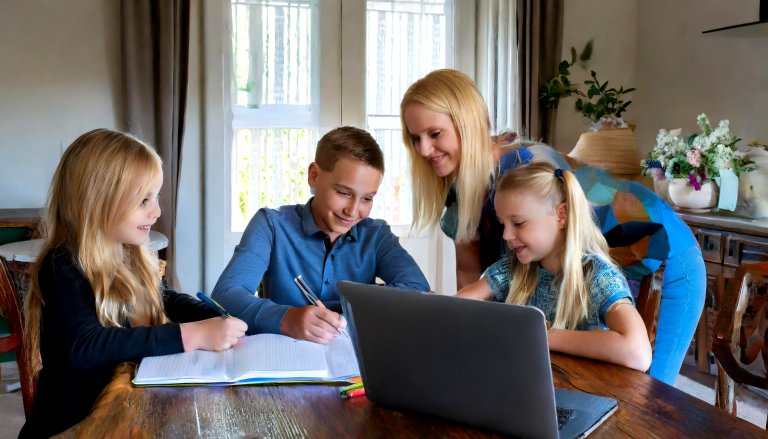Motivation Strategies for Teachers
Teaching can be rewarding yet draining, provoking the question – who motivates you to study and grow as a leader? This blog will explore practical techniques to reinvigorate teachers using research-backed strategies like work-life balance, connecting with students, collaborating, and focusing on rewards.
Maintaining motivation is difficult but crucial with crowded classrooms, demanding schedules, and diverse needs.

Discover innovative ways to reignite your passion, using “Who motivates you to study” as fuel. This will allow you to create vibrant, engaged learning and thrive alongside students.
Understanding the Importance of Teacher Enthusiasm
Every day, pupils file into classrooms and take their seats, some wide-eyed and eager to learn, others sluggish and resistant. Animate a room teeming with these diverse attitudes takes more than mere instruction. Filling this gap with a spark of magic is teacher enthusiasm.
For students, an enthusiastic teacher embodies the joy of learning. They are spellbinders who transform the mundane syllabus into an exciting narrative. Their passion spills onto their students, spurring curiosity, involvement, and deep-seated appreciation for the subject being taught.
However, teacher enthusiasm does much more than create a lively learning environment. Science backs it up, too. Research time and again reveals that teachers with an engaging demeanor positively affect students’ achievement.
Their enthusiasm can trigger students’ motivation, engagement level, and academic outcome, setting the stage for enriched learning. When teachers radiate a love for their subject, each lesson becomes a voyage of discovery, promotes experiential learning, and amplifies knowledge retention.
So, it seems like teacher enthusiasm is a secret sauce to improved education, promising to benefit teachers and learners alike.
Exploring the Role of Positive Reinforcement in Teaching
Who wouldn’t love a little pat on the back for a well-done job? Positive reinforcement in teaching is just like that. It is all about recognizing and applauding students’ good behavior or performance.
Check out the new Motivation Mentor AI Coach
app from Motivation Pay… It’s FREE!
Offering little rewards or words of praise when a student performs well helps boost their motivation and encourages them to continue delivering their best. It’s not just about gold stars and chocolates. Warm words of encouragement, smiling nods of approval, or even high-fives can be powerful motivators, too.
Undoubtedly, incorporating positive reinforcement in teaching makes learning more fun and engaging. The increased motivation levels motivate students to learn, perform, and consistently engage in positive behavior.
“I touch the future. I teach.” – Christa McAuliffe
The endearingly magical thing about positive reinforcement is that it fosters a more amicable and positive classroom environment. If the positive reinforcement of the teacher is valued, most likely the students feel appreciated and valued which leads them to participate in classroom activities.
So, a little bit of positive reinforcement can work wonders whether you are an educator or a parent. Sincerity is critical; hollow praises can do more harm than good.
Unveiling the Power of Goal Setting in Education
Whoever said setting goals was just for New Year’s resolutions or fitness challenges? It’s high time we added a big tick next to ‘Goal Setting’ in education.
And we are not just talking about the “I want to score good grades” goals. These can include skills development, behavior improvements, increased participation, or even fostering a love for learning.
Imagine a classroom bustling with motivated and focused students chasing their individual learning goals. It changes the entire dynamic. Goal setting introduces a sense of purpose and direction for the students.
It encourages personal responsibility and proactive decision-making. They no longer see learning as a dictated chore but as a stepping stone toward their ambitions and dreams. Pretty powerful, huh?
And guess what, it’s not just the students who benefit. Teachers can use goal setting to evaluate their teaching strategies, innovate instruction methods, and tailor teaching styles to suit individual student needs. So, carry the banner of goal-setting high, educators – it’s time to revolutionize the teaching-learning journey.
“Teachers can make such a profound impact on our lives and should be honored as heroes.” — Rainn Wilson
Encouraging Active Learning: Tips and Tricks
Ah, active learning, the magic potion of education. Imagine setting up your classroom as a buzzing hive of curious minds, where students actively seek knowledge rather than just digesting spoon-fed information.

It’s not just a wild fantasy; it can be a reality. Want to transform your teaching approach? No, this isn’t some infomercial peddling an educational miracle – merely a few tips and tricks up your sleeve can do the trick.
Why not start with discussions? Yes, the suitable old-fashioned method of getting students to interact with the topic. This isn’t just for those doing a language arts lesson but can be integrated into any subject.
Pose interesting open-ended questions. Foster an environment where students feel comfortable sharing their thoughts and ideas. It’s like nudging a nest of baby birds to start chirping together.
Next, consider group projects – not just socializing but also sharing and creating knowledge. Think about it: four brains to bounce ideas off are better than one! Also, make your students mini-teachers.
Ask them to lead a part of a lesson or create a presentation. This will build their understanding and leadership skills.
Remember, creating an active learning environment doesn’t take grandeur or a circus of activities. It’s about those small shifts that foster participation and curiosity.
The Benefits of Constructive Feedback in the Classroom
Imagine walking into a classroom, and each time you answer a question, the only response you get is a nod or a simple “correct.” Wouldn’t that be boring? That’s where constructive feedback steps in; it’s much like adding vibrant colors to a blank canvas.
Rich, well-intentioned feedback helps paint a fuller picture of a student’s potential, highlighting areas of strength and areas that require improvement. Constructive feedback is also a platform to acknowledge hard work, perseverance, and incremental improvements. This helps boost students’ morale and motivates them to put more effort into their work.
An additional, perhaps less considered benefit, is the empowerment that students gain in assessing and improving their learning. By receiving detailed and thoughtful feedback, students understand their learning process better, which fosters self-awareness.
This self-awareness is a crucial element in developing lifelong learning skills. Constructive feedback aids in shaping resilient learners who aren’t afraid of making mistakes but view them as opportunities for learning and growth. So, the next time you teach, layer in specific, positive, and problem-solving feedback for an optimal learning experience.
“You can’t stop a teacher when they want to do something. They just do it.” ― J.D. Salinger
Building a Growth Mindset: A Guide for Educators
Developing a growth mindset in students is the stuff of impactful education. When you cultivate a classroom where it’s all about a ‘yet’ attitude, as in “I don’t know that…yet”, you unlock endless possibilities for learners.
It’s all about pushing past the fear of making mistakes, instilling the idea that errors are not catastrophes but stepping stones on the road to understanding. This forward-looking approach can empower students, transforming challenges into opportunities for learning and growth.
So, how can you, as an educator, effectively foster a growth mindset? It goes beyond simply telling students to try harder. You’ll need to praise effort, not just achievement, highlighting that the process is just as important as the result.
Reinforce the fact that intelligence isn’t a fixed trait, but something that can be developed with persistence and dedication. Incorporate into your teaching strategies and activities that promote critical thinking, demonstrating that various paths can lead to the same solution. Remember, modeling a growth mindset yourself in the classroom shows students it’s okay to take risks and sometimes, fail.
Fostering Teacher Collaboration: Why and How
Collaboration isn’t just for students. Teachers also need to get in on this practice, and here’s why it’s super essential. When teachers get to work together, it opens up an exciting world of opportunity for growth and learning.
Real-life experience and knowledge begin to pass between the collaborators, nourishing professional and personal development. Just like when your students learn from each other in group work, you can also learn heaps from interacting with other teachers.
Now, the question comes up of how you can work towards creating more collaborative teacher communities. It’s not even half as daunting as it sounds! Start by organizing regular teacher get-togethers or set up digital platforms where educators can share, learn, and give feedback on each other’s ideas.

Remember, every teacher brings a unique skill set and different experiences. You can learn so much just by listening and responding to them. Tap into these knowledge reservoirs by creating opportunities for shared learning and watching the magic happen.
Leveraging Technology to Enhance Teaching Effectiveness
In this world marked by lightning-fast advancements, there’s no denying the magic of technology in a classroom setting. It’s like a secret ingredient that spices up the learning process, making it more interactive, stimulating, and efficient.
Whether it’s the proverbial boon of smartboards or the revolutionary charm of learning apps, technology has a knack for inspiring students to learn better, faster, and more joyfully!
Here are the tips and tricks for teachers to get the most out of this magic potion. First, brace yourselves to explore and learn the new tools. With a bit of practice and patience, it’ll be a breeze.
Next, harness the power of online platforms such as Google Classroom, or education apps to streamline the teaching process – from designing lessons, and tracking progress to giving feedback. The goal is to create a tech-savvy learning habitat where students can thrive.
• Get familiar with the technology: Don’t be daunted by the new tech tools. Take your time to understand and learn how they work. Experiment with them, make mistakes, and learn from those errors. Remember, Rome wasn’t built in a day.
• Leverage online platforms: Use digital platforms like Google Classroom or Microsoft Teams for lesson planning, assignment distribution, progress tracking, and feedback sharing. These platforms are designed to simplify these tasks while also making them more effective.
• Utilize educational apps: There’s an app for everything today – including education. From language learning apps like Duolingo to science apps like Khan Academy – there’s a wealth of resources at your fingertips.
• Gamify lessons where possible: Integrate game-based learning into your teaching process wherever you can. It not only makes learning fun but also encourages critical thinking skills.
• Foster collaboration through technology: Encourage students to collaborate on projects using shared documents or presentations on cloud-based services such as Google Drive or Dropbox.
• Use multimedia content: Enhance understanding by incorporating videos, podcasts and interactive quizzes into your lessons. Websites such as YouTube EDU provide plenty of rich content that can supplement traditional teaching methods beautifully.
• Keep student data privacy in mind: While leveraging technology is great for teaching effectiveness, it’s crucial to respect and protect student data privacy. Make sure any software or platform used complies with relevant laws regarding information security.
Remember that integrating technology doesn’t mean replacing traditional teaching methods altogether; instead, it should complement them effectively enhancing overall teaching efficacy.
Dealing with Teaching Burnout: Preventive Measures
It’s an open secret that teachers, even the most resilient ones, can hit a roadblock and experience burnout. This exhaustion’s toll could negatively impact their job performance and, by extension, their students’ learning outcomes.

Now, you might ask, “What are some ways to prevent teaching burnout?” Well, a pro tip to keep mental exhaustion at the corners is to have a healthy work-life balance. Try not to take work home. Reserve your home for relaxation and rejuvenation. Engage in hobbies and pastimes that you love — be it gardening, reading a novel, biking, or even taking your furry pet for a walk.
Reading motivational quotes will help teachers remind them of why are they teaching in the first place.
Moreover, it’s essential to remember that you’re not alone in this. Don’t be your harshest critic. Permit yourself to not be perfect. Acknowledge the hard work and dedication you put in each day.
If things get too overwhelming, don’t hesitate to reach out for professional help. And always ensure to maintain a peer support network where you and fellow educators can relieve each other’s stresses.
Share your journey, including the highs and lows, with like-minded people. It’s incredible to see how this exchange can provide the necessary perspectives and solutions to overcome burnout. Now, let’s power through this, yes? You’ve got all the pieces assembled; it’s just a matter of putting them into place.
Final Thought
Implementing even a few of these techniques can revitalize educators who feel overwhelmed or disengaged. But remember, motivation is important for teachers too – take time to recharge your passion so you can inspire students. Make self-care, creativity and collaboration regular habits, not just occasional indulgences.
The rewards of guiding young minds will resonate through generations. Stay open to new inspirations – from mentors, professional development, or even your students. By actively nurturing your passion as an educator, you can create vibrant learning communities where you and your students can thrive together.







